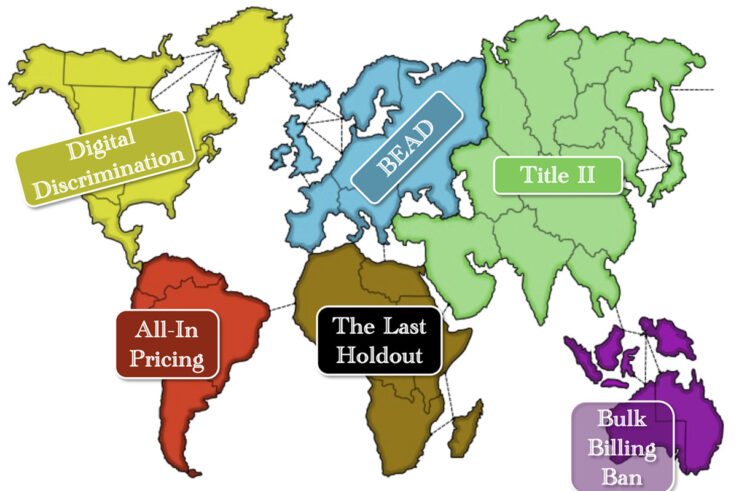This article is a part of the The Law & Economics of Interchange Fees Symposium symposium.
In our earlier post, we observed that the GAO report on interchange got off on the wrong foot when it concluded that interchange fees were rising. We infer from the silence which greeted our post that everyone agrees with this criticism. Indeed, yesterday’s posts and comments appear to agree that the GAO’s report does very little to advance the discussion of interchange or the cost of electronic payment. But we suspect that greater disagreement lies just around the corner.
A number of posts yesterday promised to address the claim on which the criticism of modern payment systems rests–the extent to which the discount that merchants pay to accept most electronic payment systems in the U.S. imposes a tax on legacy payment instruments such as cash and check Mark Seecof seized upon this point in his comment on Ron Mann’s post. According to Mark, the “big problem” with the payment card industry is that discount fees are used to fund rewards programs, and he claims that society as a whole would be better off if the government simply forbid networks from enforcing their honor all cards rules and force networks to negotiate acceptance on a program-by-program, issuer-by-issuer basis. The claim that increasing transaction costs will produce more efficient outcomes is a curious one. But we’ll save that issue for a later day. Rather, with this post we intend to take up the predicate of Mark’s post–that discount fees on electronic payments shift costs to users of legacy payment instruments.
At the outset, we note that discount fees, unlike interchange, are a feature of virtually all private payment instruments. Thus, if there is something to the notion that discount fees tax other forms of payment, then the criticism applies as much to American Express and Discover as it does to MasterCard and Visa. In our view, however, although this criticism is oft repeated, repetition obscures a number of problems.
First, cross-subsidies are ubiquitous in any complex economy. Consumers receive free refills on drinks in restaurants, free parking at shopping malls, goods below cost in supermarkets (via loss leaders), relatively inexpensive newspapers because advertisers pay most of the costs, and many similar benefits. To bring buyers and sellers together through such intermediaries as newspapers, supermarkets, and credit cards, one side frequently receives inducements to participate. These inducements help maximize the joint value of the ultimate transaction for the parties. Rather than an inefficient “subsidy,” these inducements are the lubricant necessary to make the economic machine work at its best.
Second, from a social policy perspective, whether interchange forces legacy buyers to pay more should raise a concern only if legacy is more efficient. But it’s not. It is hard to believe, as some people suggest, that credit cards and other electronic payments are more expensive than cash and checks. In fact, legacy payments have several limitations that create costs for both consumers and merchants. Cash only works well when the good and payment are exchanged simultaneously. And the technology of cash does not support the instantaneous decision to give credit to the person buying; rather, the buyer has to arrange credit separately with a financial institution. In addition, with cash, you have no recourse against fraud, other than bringing suit. (On the costs of cash, see Daniel D. Garcia Swartz, Robert W. Hahn, and Anne Layne-Farrar, The Move Toward a Cashless Society: A Closer Look at Payment Instrument Economics, Vol. 5, Issue 2, Review of Network Economics 175, 192 (June 2006) (describing cash as “among the most costly payment method[s] for society”)). Similar transaction costs and risks accompany the use of checks.
By contrast, there are numerous benefits to using credit cards and other electronic payments. For consumers, these benefits include the extension of credit real-time, the reduction of risk, automated dispute resolution, and better record keeping, as Garcia-Schwartz, Hahn and Layne-Farrar demonstrate. For merchants, accepting credit cards allows them to make sales on credit at a generally lower cost than operating their own credit program. And merchants can receive faster and more certain payment from customers using cards than from customers using other means, such as checks.
Third, and most significantly, the rapid growth of online payments within the retail industry is rendering legacy payments obsolete. The GAO itself seems generally aware of the shift from legacy to electronic payments. Indeed, it cites the Federal Reserve’s recent estimate that the use of both checks and cash have declined, or at least grown more slowly than credit and debit card use, since the mid-1990s as more consumers switched to electronic forms of payment. Since 2005, more than half of total retail transactions have used either credit or debit cards. Large national merchants report that sales made with cash and checks have decreased in recent years, while sales made with credit and debit cards have increased.
But the GAO ignores that the argument in favor of regulating interchange to protect cash and check users, whatever its overall merits, is logically limited to areas where legacy forms of payment can be used. And those areas are quickly vanishing. For example, even if a study of the 1980s retail gasoline market were to suggest the existence of cross-subsidies then—a debatable conclusion—that study cannot be read to suggest the existence of such a subsidy among people who shop on-line or who buy their gas at automated fuel dispensers. According to scholars, we are rapidly moving towards a cashless society where no one uses legacy instruments such as cash or check. And there is simply no reason to believe that this move is driven by the inherent inefficiency of electronic payment or an implicit tax on users of cash or check.
The GAO’s misplaced concern for users of legacy payments is yet another example of a theoretical objection to unregulated interchange that finds no support in the facts. According to Garcia-Schwartz, Hahn and Layne-Farrar, “the shift toward a cashless society appears to improve economic welfare,” with consumers the party most likely to benefit. But, if history repeats itself, we will likely have to continue to endure the interchange debate regardless of the facts. As the GAO’s report again reminds us, merchants simply want to pay less for the benefits that credit cards provide. Not surprisingly, they are in this debate for themselves, not their consumers.





